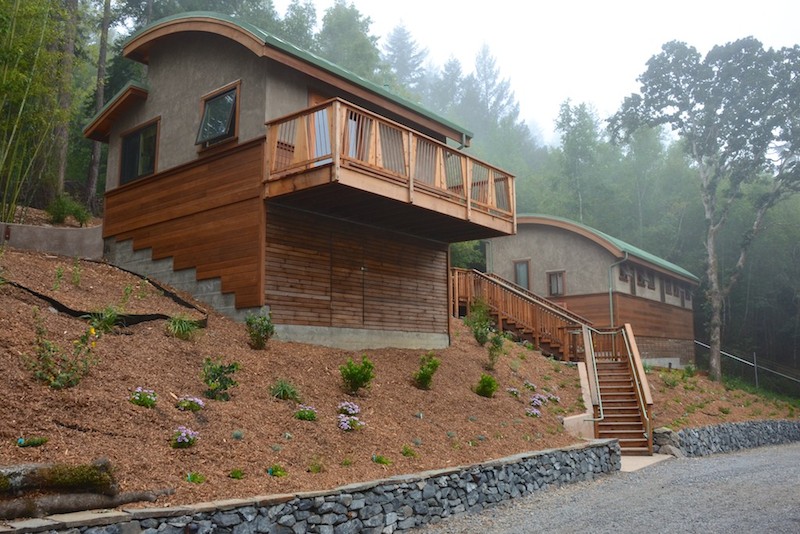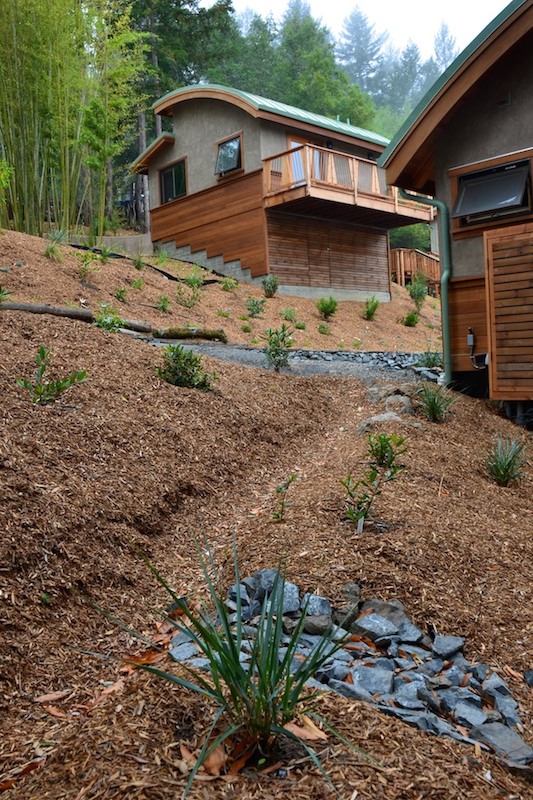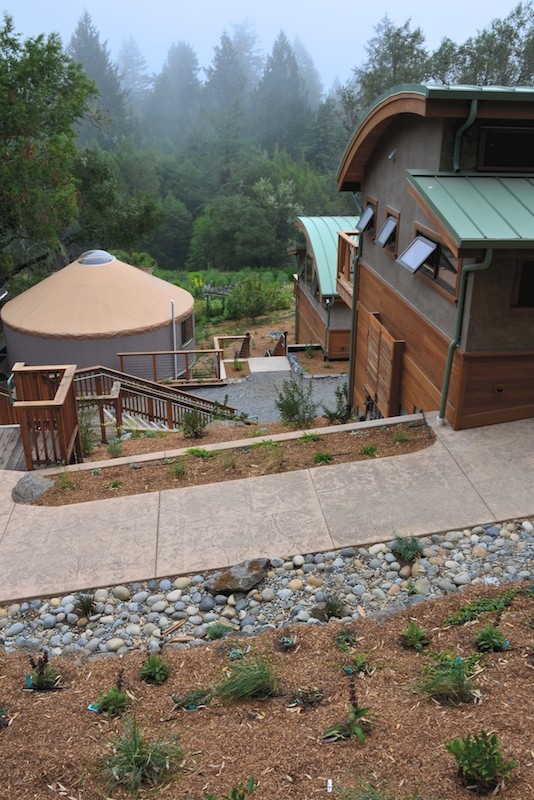We are thrilled to announce the completion of our three new guest housing units, built to provide beautiful and comfortable accommodations for a more diverse array of our constituents. Being a demonstration site, we sought to answer the question, “How can we build in a site-appropriate, ecologically friendly way within the constraints of commercial construction codes for Sonoma County?” Our strategies are detailed below!
Materials
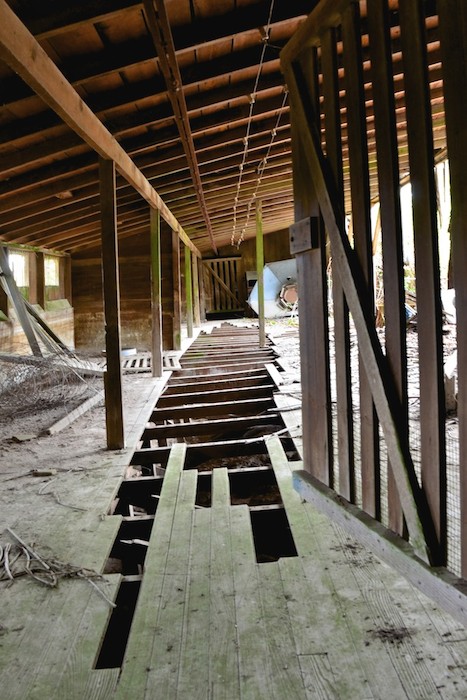
One of the most interesting stories behind the new guest housing materials is hidden in the wood. Benjamin Akutagawa, a Sebastopol resident, donated old growth redwood lumber from an 100-year-old redwood chicken house to OAEC for our project. The chicken coops on Ben’s property were built in the late 20s, when poultry farming was a thriving occupation in Sonoma County. Ben’s father, a Japanese-American, bought the farm in 1953 after being forcibly separated from his family and held in an internment camp in Colorado during World War II.
We used the recycled redwood from the disassembled coop for subfloor facing, interior window and door trim and baseboards, and for our custom-built desk and cabinet units inside the rooms. Also, all of the exterior redwood siding of our new buildings comes from salvaged redwood logs.
Other recycled or eco-friendly materials include:
- The framing lumber we chose is Forestry Stewardship Council (FSC) certified from sustainably managed forests.
- For our seismically sound foundations, we chose reclaimed concrete aggregate—old concrete crushed and made into new concrete aggregate. We also used cement with 25% fly-ash, which is a byproduct of coal plants that would otherwise be a waste product.
- The buildings’ exterior skin is plaster with a lime finish, which is an earth-based catalyzing agent. This is an alternative to using energy-intensive stucco, which is a cement-based finish.
- All of the floor insulation is recycled cotton bats—fiber from textile factories that may have otherwise gone into the landfill is shredded and made into insulation bats. The wall insulation is blown cellulose.
- The buildings’ heating and cooling systems involve heat pumps, which are more efficient than standard resistive electrical systems.
- The flooring is cultivated bamboo. Though imported, bamboo has a smaller ecological footprint than flooring cut from big trees because bamboo replenishes itself at a much faster rate than wood.
- All the lighting is LED, which is the most efficient lighting currently available.
- The beds all came from a company in Chicago that makes inner-spring mattresses out of recycled and organic materials.
- Lastly, we chose to install metal standing seam roofs because they have the longest life span of any conventional roofing systems and provide clean roofwater for our landscaping.
Landscaping and Water Considerations
We took great care to design landscaping around the new guest housing that would be responsive to the drought and climate considerations of this region. Working with Paolo Tantarelli and Jeff Shields at Community Soil, we came up with a plan to ensure that little to no water would leave the landscape. We achieve this through a system of swales, mulch basins, deep mulching and intensive planting. Recognizing we are in the semi-arid west, the plants are mostly natives and pollinators that will need little or no water in the summer after 2-3 years of getting situated.
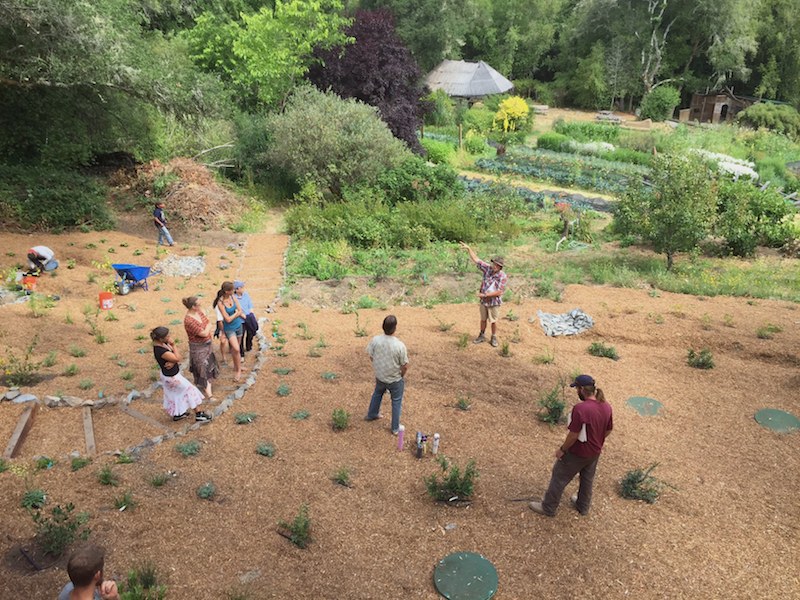
Drought-tolerant California natives (with an emphasis on indigenous food crops) in our landscaping include:
- Perennial edibles like thimbleberry, huckleberry, elderberry, hazelnut, salmonberry and alpine strawberries.
- Medical herbs such as yerba buena and white sage.
- Coffee berry and coast silk tassel bush will create a canopy above the understory shrubs. (Since the area where the new guest housing is located was once a bay forest, we want the buildings to be nestled in foliage and plant life.)
- Pollinator plants like coyote mint, seaside daisy, Cleveland sage, California pipevine, flannelbush and Saint Katherine’s lace are planted at eye level, so people will be able to gaze at flowers covered in pollinators as they descend the exterior staircases. Some of this foliage, such as Cleveland sage, is very fragrant—creating a sensual experience both visually and tactilely.
- Water-averse plants such as lupin and ceanothis are planted on the extreme ends of the landscape, where rooftop water runoff will not reach.
All buildings and hardscaped areas create impervious surfaces, meaning that the ground under a building that would normally be available to absorb water is no longer available. Water that would normally seep into the ground will now flow off rooftops and get concentrated somewhere (for instance, in urban environments, it flows into storm drains). We took this opportunity to capture roof, subsurface and surface water with a series of swales built into the landscape.
We are also utilizing graywater from the buildings to help irrigate the landscape. All water from sinks and showers drains into mulch basins—1.5 foot deep trenches that are surrounded by plants that can handle the extra moisture during the summer. Thus, we are asking all of our course and training participants to leave their body lotions and products at home and use our biodegradable soaps, shampoos and conditioners. Visitor Information >
Energy
The new guest housing is on a north-facing slope, so we chose not to install rooftop solar panels that would inevitably give a low return on electricity. Instead, in 2017, we are planning on building a new, larger meeting room with a new solar array (our current meeting room has a 10 kW system). We did, however, maximize the amount of south-facing glass for solar gain in our new guest buildings.
Inside the buildings, we chose not to use propane. All appliances are electrical, as that is what we can generate ourselves onsite.
Composting Toilets (Eventually)
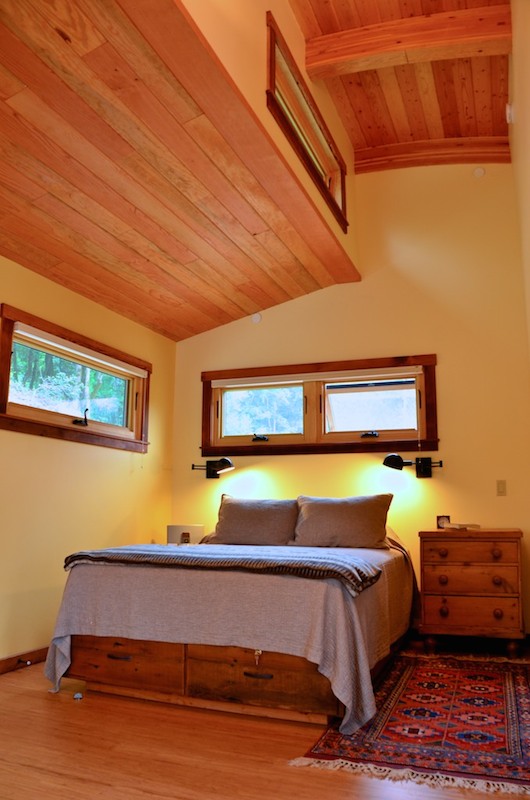 The slope of the landscape provided us an opportunity to eventually install composting toilets in our new buildings. We are waiting for a permit from the county to convert the existing flush toilets to composting systems. The buildings were designed to allow a retrofit of the structures’ waste management systems with the greatest ease.
The slope of the landscape provided us an opportunity to eventually install composting toilets in our new buildings. We are waiting for a permit from the county to convert the existing flush toilets to composting systems. The buildings were designed to allow a retrofit of the structures’ waste management systems with the greatest ease.
Labor
We carefully chose local craftspeople to work with on this project to ensure the longevity and energy efficiency of our buildings. Both our architect Lars Langberg and general contractor Kirk Hopkin are forward-thinking and ecologically conscientious, and we are honored to have worked with them.
Bernie Jungle, former Facilities Manager at OAEC, handcrafted all of the cabinetry and desk and closet units inside the rooms. Instead of choosing stock furniture, we felt it was a good use of money to pay a highly skilled craftsperson to use top-quality wood to fit the spaces exactly.
Yurts
We also remodeled our preexisting dormitory yurts, so they are now as comfortable as the new guest housing buildings. Improvements include insulated floors, walls and ceilings; refinished floors; ladders for easier access to the upper bunks; new heating units; new shelving; and standard double pane sliding windows to replace the former Velcro vinyl windows.
